.
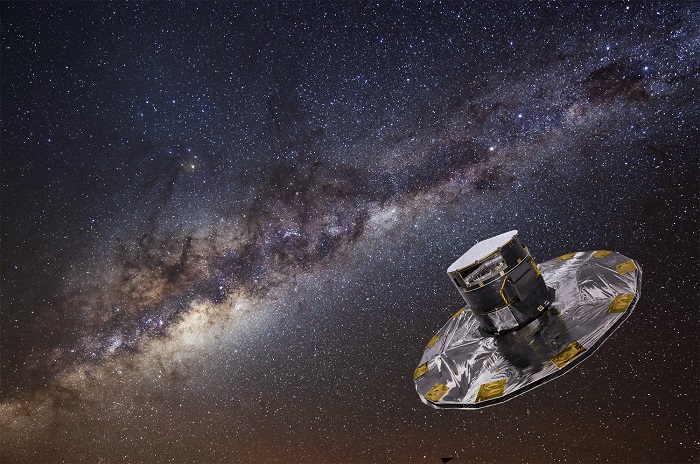
Gaia is a global space astrometry mission. It will make the largest, most precise three-dimensional map of our Galaxy by surveying more than a thousand million stars.
In this blog we'll cover the activities from Kourou from once the spacecraft has left the clean room in Toulouse until launch.
.
The main goal of the Gaia mission is to make the largest, most precise three-dimensional map of our Galaxy by surveying an unprecedented one per cent of its population of 100 billion stars.
During the mapping, Gaia will detect and very accurately measure the motion of each star in its orbit around the centre of the Galaxy. Much of this motion was imparted upon each star during its birth and studying it allows astronomers to peer back in time, to when the Galaxy was first forming. By constructing a detailed map of the stars, Gaia will provide a crucial tool to study the formation of our Galaxy, the Milky Way.
While surveying the sky, Gaia is bound to make many other discoveries. During its anticipated lifetime of five years, Gaia will observe each of its one billion sources about 70 times, resulting in a record of the brightness and position of each source over time. Together with the unprecedented accuracy of the astrometric measurements, this will lead to the discovery of: planets around other stars, asteroids in our Solar System, icy bodies in the outer Solar System, brown dwarfs, and far-distant supernovae and quasars. The list of Gaia's potential discoveries makes the mission unique in scope and scientific return.
Huge databases of information will be compiled from the Gaia data, allowing astronomers to trawl the archives looking for similar celestial objects or events and other correlations that might just provide the clue necessary to solve their particular, seemingly intractable, scientific puzzle.
The Spacecraft
The Gaia spacecraft is comprised of a payload module, a mechanical service module and an electrical service module and has a launch mass of around 2 tonnes. The payload module is built around the hexagonal optical bench (~3m diameter) which provides the structural support for the single integrated instrument that comprises three functions: astrometry, photometry and spectrometry. It further contains all necessary electronics for managing the instrument operation and processing the raw data.
The mechanical service module comprises all mechanical, structural and thermal elements supporting the instrument and the spacecraft electronics. It also includes the micro-propulsion system, deployable sunshield, payload thermal tent, solar arrays and harness.
The electrical service module offers support functions to the Gaia payload and spacecraft for pointing, electrical power control and distribution, central data management and radio communications with the Earth.
The L2 Orbit
Gaia will be placed in an orbit around the Sun, at the second Lagrange point L2, which is named after its discoverer, Joseph Louis Lagrange (1736-1813). For the Sun-Earth system, the L2 point lies at a distance of 1.5 million kilometres from the Earth in the anti-Sun direction and co-rotates with the Earth in it's 1-year orbit around the Sun.
One of the principal advantages of an L2 orbit is that it offers uninterrupted observations, since the Earth, Moon and Sun all lay within the orbit of the L2 point. From L2 the entire celestial sphere can be observed during the course of one year. To ensure Gaia stays at L2, the spacecraft must perform small manoeuvres every month.
Gaia will not be the only ESA mission going to L2. Herschel and Planck have operated from there and currents plans call for JWST to be placed there, too.
The Hipparcos Mission
Gaia is not the first space mission to chart the heavens. In 1989, ESA launched Hipparcos. Sounding like the name of Hipparchus, the Greek astronomer, its different spelling reflects that the name was also an acronym for High Precision Parallax Collecting Satellite.
This entirely European mission was the first satellite to chart the positions of stars and produced a primary catalogue of about 118 000 stars, and a secondary catalogue, called Tycho, of over 2 million stars whose positions were determined to slightly less precision. The data is now widely used by the entire community of professional astronomers.
Among other results, Hipparcos' data contributed to the prediction of when comet Shoemaker-Levy 9 would collide with Jupiter. The data showed that many billions of years ago, the Galaxy swallowed a large group of stars. Hipparcos also helped astronomers to refine the age of the Universe.
The Challenge of Gaia
Gaia will significantly improve on Hipparcos for a number of different reasons. For example, the collecting area of the primary mirrors means that Gaia will collect more than 30 times the light of its predecessor, allowing for more sensitive and accurate measurements.
Gaia will be able to measure a star's position and motion 200 times more accurately than Hipparcos. Changes in a star's position and motion are registered as tiny angles. As a comparison, if Hipparcos could measure the angle that corresponds to the height of an astronaut standing on the Moon, Gaia will be able to measure his thumbnail!
Highly efficient cameras, CCDs, will be used to record the images, so wide-angle images of many celestial objects can be obtained at the same time. Devices known as photocathodes were used on Hipparcos, which meant that the satellite could only record information from a single celestial object at a time.
Astronomers will have the challenge of dealing with a flood of data when Gaia begins its work in 2013. Even after being compressed by software, the data produced by the five-year mission will fill over 30 000 CD ROMs. This data will be transmitted 'raw' and will need processing on Earth to turn it into a calibrated set of measurements that can be freely used by the astronomical community.
So, not only must ESA design and build the spacecraft itself, they must also develop new computer software that will ensure the data can be processed efficiently once it is back on Earth.
.
The primary objective of the Gaia mission is to survey more than one billion stars in our Galaxy and beyond. Data from this astronomical census will allow astronomers to answer some fundamental questions about the formation and evolution of our Galaxy, and will provide insight into many other topical areas of astronomy. Some of these are briefly mentioned below.
Main Objectives
Gaia is designed with a single, primary goal in mind: to investigate the origin and subsequent evolution of our Galaxy, the Milky Way. To do this, it will conduct an astronomical census of 1 billion stars, allowing astronomers to build the most accurate three-dimensional map to date of the celestial objects in our Galaxy.
Gaia's mission is scheduled to last for five years. During that time, it will log the position, brightness and colour of every visible celestial object that falls within its field of view. By repeating these observations throughout its mission, astronomers will be able to calculate the distance, speed and direction of motion of each of the celestial objects, chart variations in their brightness, and determine whether they have nearby companions.
This kind of data is the lifeblood of astronomy, and Gaia will gather it with unprecedented accuracy. It will allow astronomers to painstakingly piece together the history of our Galaxy, since each celestial object preserves something of the era during which it was born.
The History of the Milky Way
Our Galaxy is the product of the stars it contains. Just like a city, the Milky Way is split into different locales and surrounded by suburbs. Each of these different areas has their own characteristics that show up in the stars' orbits and chemical composition. Gaia's observations will enable astronomers to identify these regions one from another.
As stars condense out of celestial clouds of gas, they naturally incorporate the chemicals found in space. The stars then process this material in their hearts and expel it at the end of their lives. This enriches the galaxy with new, heavier chemical elements that are incorporated into the next generation of stars. Gaia will be able to discriminate between these different generations and so build up a picture of the way the Galaxy was born and subsequently evolved.
Planet Detection
For stars within a distance of approximately 150 light-years from the Sun, Gaia is expected to find every Jupiter-sized planet with an orbital period of 1.5 - 9 years. It will do this by watching out for tiny wobbles in the star's position. This behaviour is caused when a star is tugged by the gravitational pull of a planet in orbit around it. In our own Solar System Jupiter, and to a lesser extent all the other planets, do this to the Sun, making it wobble. Estimates suggest that Gaia will detect between 10 000 and 50 000 planets beyond our Solar System.
The Brown Dwarf Desert
A brown dwarf is a failed star, which fell short of accumulating enough mass to ignite nuclear fusion in its heart. Vast numbers of brown dwarfs are thought to drift, as vagabonds, across interstellar space. Astronomers also expect to find them in orbit around stars, but observations from telescopes on the Earth are not finding this particular type of brown dwarf in their expected quantities. The paucity of brown dwarfs orbiting other stars has been dubbed 'The Brown Dwarf desert'.
Gaia will detect tens of thousands of brown dwarfs, both drifting through space and in orbit around other stars, if they are there. The data is vital for astronomers to investigate how stars form, as the brown dwarfs represent the ones that did not make it. The more gas there is locked inside brown dwarfs, the less there is to make real stars.
Asteroids and Solar System Discoveries
Closer to home, there is currently great scientific and public interest in detecting our Solar System's inventory of asteroids and comets. Gaia will contribute to this search because of its unprecedented sensitivity to faint, moving objects. It is expected that the spacecraft will detect tens of thousands of minor planets. Some of them will be near-Earth objects (NEOs), others will live in the 'main-belt' of asteroids between Mars and Jupiter, yet more will be located in the icy realms of the outer Solar System known as the Kuiper Belt.
It is also possible that Gaia will discover 'Planet X' - if such an object exists. Ever since Pluto was discovered in 1930, a number of astronomers have believed in the existence of a tenth planet, out beyond Pluto. The hypothetical planet has been searched for many times but, obviously, not yet found.
Exploding Stars
During Gaia's five-year lifetime, calculations suggest that the spacecraft will detect some 100 000 exploding stars (supernovae) in distant galaxies, before they reach their maximum brightness. This will provide an early warning system for astronomers on Earth who wish to study them and use them to gauge distances to the host galaxies.
It is essential to observe such supernovae as they are still climbing in brightness. This is because the peak brightness they reach is the essential measurement for calculating their distance. Far out in space, Gaia will be in a prime location to make such observations.
Testing Einstein's General Relativity
Gaia's scientific harvest will allow Einstein's theory of General Relativity to be tested as never before. This is because the accuracy to which the spacecraft can measure positions is so great that usually negligible gravitational effects will show up in the data.
One such distortion is the bending of light by massive objects. As light passes by the Sun, or a planet in our Solar System, it is deflected slightly by that object's gravitational field. This means that the star's position will appear to move slightly. Gaia will detect this shift and allow the most precise measurement of this effect ever.
Another consequence of General Relativity is its prediction that the fabric of space, the so-called space-time continuum, can 'ripple'. These movements, called gravitational waves, cause distortions that will alter the apparent position of a star. As yet, gravitational waves remain undiscovered but Gaia's precision observations will allow astronomers to calculate upper limits on their strength. This will help to pin down the accuracy that gravitational wave 'telescopes' will need to achieve if they are to detect these elusive ripples.
Another tantalising possibility is that the strength of gravity is changing slightly every year. Whilst this can only be a minuscule variation even during a human lifetime, it could mount up into something significant over billions of years. Gaia will pinpoint white dwarfs, the cooling remains of dead stars. These give out heat for billions of years according to their pull of gravity. The amount of heat they give out determines how brightly they shine. If the strength of their gravity has decreased, then the white dwarfs will be dimmer than expected. So Gaia's census of white dwarfs will afford astronomers an insight into the amount of any decrease in gravity that has taken place.
.

Gaia spacecraft at Astrium, packed in its high-tech case. Credit: Astrium SAS
.
With the final tests and the Mission Flight Acceptance Review successfully concluded, Gaia is now ready for launch and has been assigned a launch window from 17 November to 5 December 2013. Meanwhile Gaia has been ‘switched off' and packed, and will be shipped to Kourou in the second half of August in order to prepare for its launch. Ready to go at last!
The Gaia spacecraft is seen here at the Astrium premises, being packed in its high-tech case in preparation for shipping to Kourou.
The shipment of Gaia will take place in two steps:
The spacecraft will leave Toulouse on 22 August at 20:00, landing in the early morning of 23 August at Cayenne.
The deployable sunshield together with its umbrella-like mechanism will be dispatched in a separate shipment on 28 August.
Both transports will be flown by an Antonov 124 - one of the largest aircraft in the world.
The team in Kourou
The ‘early team’ will leave a couple of days ahead of the first Antonov and will welcome the spacecraft in Cayenne, taking care of the initial phases of the launch campaign, including transport by road from the airport to the clean rooms of the launch site, unpacking and initial inspections. Ared, Joe and David will be in the early team, and Giuseppe will fly with the spacecraft on the first Antonov. He will tell us afterwards if it is more comfortable than the regular Air France.
.
Gaia shipment to Kourou in Antonov airplane
Yesterday, Gaia was transported in a special convoy from the Astrium premises to Toulouse-Blagnac airport from where it departed for the launch site in Kourou in an Antonov plane.
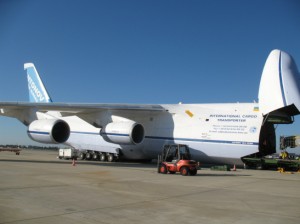
The plane was already waiting at the runway when the container with Gaia arrived: An Antonov 124-100, the second largest plane in the world (after A380), capable to carry up to 150 tonnes.
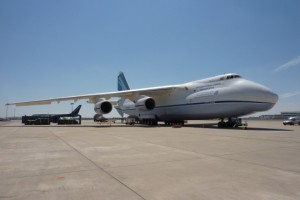
After closing the nose of the plane and the back, the aircraft is ready to take off.
.
ESA’s billion-star surveyor, Gaia, departed yesterday evening from Toulouse and arrived early this morning in French Guiana. Gaia will be launched later this year from Europe’s Spaceport in Kourou on a five-year mission to map the stars of the Milky Way with unprecedented precision.
Built by Astrium in Toulouse, the Gaia spacecraft took off on board an Antonov 124 heavy-lift aircraft at 20.00 yesterday from Toulouse airport with the destination of Cayenne, the capital of French Guiana. The spacecraft will now be transported by truck to Europe’s Spaceport in Kourou, 64 km from Cayenne.
“This is a very exciting day for the Gaia mission and all the teams involved, who have worked for years to get to where we are today,” says Giuseppe Sarri, ESA’s Gaia project manager. “Arriving in Kourou and starting the launch campaign is a great achievement.”
Gaia’s main goal is to create a highly accurate 3D map of our galaxy, the Milky Way, by repeatedly observing a billion stars to determine their precise positions in space and their motions through it.
A billion stars is roughly 1% of all the stars spread across the Milky Way, providing a representative sample from which the properties of the whole galaxy can be measured. Gaia will measure these stars from an orbit around the Sun, near a location known as the L2 Lagrangian point, some 1.5 million km beyond Earth’s orbit.
Other measurements will assess the vital physical properties of each star, including its temperature, luminosity and composition.
The resulting census will allow astronomers to determine the origin and the evolution of our galaxy.
Gaia will also uncover tens of thousands of previously unseen objects, including asteroids in our Solar System, planets around nearby stars, and exploding stars – supernovae – in other galaxies.
Sarri, who also flew on the Antonov aircraft with Gaia, said that the flight from Europe to South America went smoothly. “We are now looking forward to the coming weeks of final preparation, which we will undertake with the same care and determination that the teams have shown so far when building the spacecraft.”
On 28 August, a second Antonov 124 aircraft will carry Gaia’s sunshield and most of the ground support equipment from Toulouse to Cayenne. At that point, all the spacecraft parts and equipment will have arrived in French Guiana, leading towards the launch later this year.
Quelle: ESA
.
Update: 24.08.2013
,
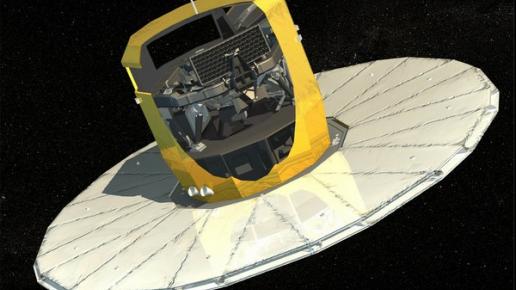
The eye of Gaia
The largest digital camera ever built for a space mission has been painstakingly mosaicked together from 106 separate electronic detectors. The resulting ‘billion-pixel array’ will serve as the super-sensitive ‘eye’ of the European Space Agency (ESA) galaxy-mapping Gaia mission.
At its Toulouse site, Astrium is making final adjustments to the scientific instruments for the Gaia satellite, which from 2013 will start mapping more than a billion stars in the Milky Way. As well as drawing up a 3D map of our galaxy, this mission will also verify Einstein’s general theory of relativity with greater precision than ever before.
In mid-September, Vincent Poinsignon witnessed the culmination of years of work. He had before him the largest digital camera ever built, with a total of a billion pixels. Vincent, who heads up the Gaia project at Astrium, maintains that from the Earth this camera could have measured a freckle on Neil Armstrong’s face as he took his first steps on the moon. The camera has now been integrated in the payload module of the Gaia satellite, built by Astrium for ESA, and is being tested in Astrium’s cleanroom facility in Toulouse. In late 2013, it will be launched from the European Spaceport in French Guiana and placed in orbit to assume its role as the most powerful ‘eye’ ever to observe the Milky Way.“In astrometric terms, Gaia will have a precision 100 to 1,000 times greater than its predecessor Hipparcos,” explains Vincent. When ESA launched Hipparcos in August 1989 it was the first satellite devoted to astrometry, a branch of astronomy involving measurement of the position and movements of celestial bodies as well as their distance from the Earth. Up until its ‘retirement’ in 1993, it amassed a catalogue of 120,000 stars with a precision 200 times greater than any other previous measurements. Now, Gaia’s eagle eye makes Hipparcos seem as blind as a bat. Once in orbit around the sun, the new satellite will begin to precisely measure the characteristics of a billion stars which will then be used to generate a 3D chart of our galaxy. This sensitivity will enable it to detect more than 250,000 objects in our solar system (mostly asteroids), 15,000 extrasolar planets, 50,000 brown dwarfs and around 20,000 supernovae.
A diamond in space
Gaia’s exceptional capabilities have come about through years of work by a team of over 500 people at Astrium, explains Vincent Poinsignon, who was previously project manager for Mars Express, the first European mission to the Red Planet. Gaia contains two telescopes which in combination are powerful enough to detect stars 400,000 times fainter than the human eye can see. The weak light of these celestial bodies is captured on a focal plane the two telescopes share, which consists of 106 charge-coupled devices (CCDs), an advanced version of the chips in standard digital cameras.

.
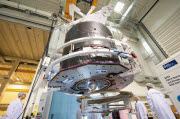
A key feature of the CCD support structure and the rest of the satellite is the use of silicon carbide, a material with ceramic properties originally developed as a diamond substitute which is incredibly light and resistant to deforming under temperature changes.
Astrium has already used this material on other satellites, including the Herschel space observatory launched in 2009. The 3.5-metre mirror of Herschel’s large telescope, made entirely of silicon carbide, weighs a mere 270 kilograms compared to the 1,500 kilograms it would have weighed using standard technology. Now the use of silicon carbide will enable Gaia to function at temperatures of -110°C to increase the sensitivity of its sensors. A deployable sunshield with a length of around 10 metres will keep its instruments in the shade at all times to protect them from the sun’s heat. “Gaia’s innovations include the micropropulsion system and the antenna, along with the generalised use of silicon carbide not only for the telescope mirrors but also for many parts of the payload module,” highlights Timo Prusti, Gaia Project Scientist at ESA.
As Timo indicates, the antenna plays a vital role. The satellite will detect and measure the characteristics of hundreds of stars per second practically uninterrupted during its five-year mission. Each star will be monitored around 70 times with a precision “that could divide the moon into 180 million slices from the Earth”, he says. Every day, Gaia’s antenna will need to send 50 gigabytes of data to the Earth over a distance of 1.5 million kilometres. At the end of the mission, scientists will have gathered one petabyte of data, equivalent to the information stored on 200,000 DVDs.
Relativity takes centre stage
The Gaia mission was proposed in 1993 by Swedish astronomer Lennart Lindegren of Lund University. His idea will take to the skies 20 years after it took shape in his mind. Lennart, one of the world’s foremost astrometry experts, points out that Gaia will also verify with greater precision than ever Einstein’s general theory of relativity, which states that mass causes spacetime to curve. Even light rays are bent when they pass near a massive object such as the sun. “Gaia will measure this effect a few orders of magnitude more precisely than ever before and will also observe the deflection of light rays caused by Jupiter, the Earth and other planets,” says Lennart. “We expect all these measurements to be in line with the general theory of relativity and accordingly to confirm our current understanding of the structure of spacetime. However, it is part of scientific method to constantly test accepted theories in the most rigorous manner possible and Gaia will be a hard taskmaster in this sense,” he continues.In the early 17th century, the Florentine astronomer Galileo Galilei tried to convince the cardinals of the Inquisition that the universe is “written in the language of mathematics, and its characters are triangles, circles and other geometric figures, without which it is humanly impossible to understand a single word of it”. According to Galileo, without these characters “one is wandering around in a dark labyrinth”. Four centuries later, Gaia is preparing to shed light on this labyrinth with the ‘luminous’ mathematics of astrometry – although there is still much to be done. The one billion stars to be mapped by Gaia make up barely one percent of the stars in our galaxy. The remaining 99% will have to wait for Hipparcos’ and Gaia’s successors …
.
Gaia: recording over a billion stars for an extraordinary 3-D map of the galaxy
Gaia is a global space astrometry mission, and a successor to the ESA Hipparcos mission. Part of ESA’s long-term scientific programme, Gaia is being built by Astrium and is expected to be launched in 2013 on a Soyuz vehicle.
It will conduct a census of a billion stars in our galaxy, monitoring each of its target stars about 100 times over a five-year period, precisely charting their distances, movements, and changes in brightness. It is expected to discover hundreds of thousands of new celestial objects, such as extra-solar planets and failed stars called brown dwarfs. Within our own solar system, Gaia should also identify tens of thousands of asteroids.
Additional scientific benefits include detection and characterisation of tens of thousands of extra-solar planetary systems, a comprehensive survey of objects ranging from huge numbers of minor bodies in our solar system, through galaxies in the nearby Universe, to about 10 million galaxies and 500,000 distant quasars. It will also provide stringent new tests of general relativity.
The spacecraft will use the global astronomy concept successfully demonstrated on Hipparcos, also built by Astrium, which successfully mapped 100,000 stars in 1989. Gaia will be equipped with a latest-generation payload integrating the most sensitive telescope ever made. This cutting-edge technology draws on Astrium’s extensive experience particularly on silicon carbide (SiC) telescopes, used on the Herschel telescope and Aladin instrument as well as on three Earth observation satellites (Formosat, Theos and Alsat 2). Gaia’s measurement accuracy is so great that if it were on the Moon, it could measure the thumbnail of a person on Earth!
Gaia will be placed in orbit around the Sun, at a distance of 1.5 million kilometres further out than Earth, at the L2 Lagrangian point of the Sun–Earth system.
Quelle: Astrium
.
Update: 25.08.2013
Arianespace to “reach for the stars” with its Soyuz launch of Europe’s Gaia space surveyor spacecraft
.
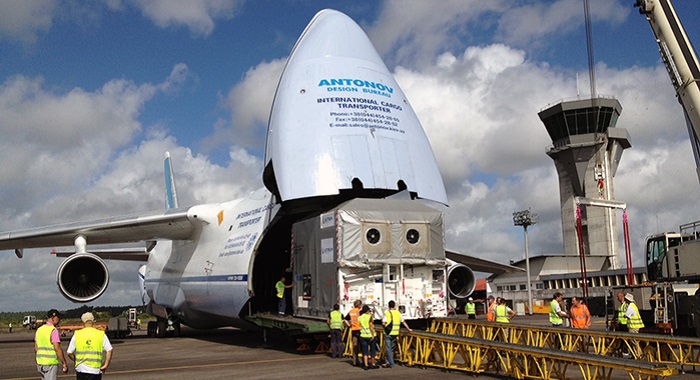
Shown in its protective shipping container, Europe’s Gaia is unloaded from the cargo jetliner that transported this advanced “star-mapper” spacecraft from Toulouse, France – where it was built by Astrium – to French Guiana.
.
Soyuz Flight VS07
Europe’s Gaia “star-mapper” has arrived in French Guiana for an Arianespace Soyuz launch later this year on a mission to chart the locations and motions of a billion stars, while also opening opportunities in discovering new celestial objects in the hundreds of thousands.
Gaia was delivered today aboard a chartered Antonov An-124 cargo jetliner at Félix Eboué International Airport near the capital city of Cayenne – clearing the way for its transfer via road to the Spaceport.
With a liftoff mass of 2,030 kg. – which includes the spacecraft’s two optical telescopes, three science instruments, as well as a 10-meter deployable “skirt” as a sunshield and a power generator – Gaia will observe one billion stars approximately 70 times each over five years.
A truly impressive space charting mission
Many aspects of this mission – organized by the European Space Agency – are impressive. The spacecraft carries one of the largest digital cameras to be placed in space (with nearly one billion pixels), and is designed to detect celestial objects that are a million times fainter than the unaided human eye can see.
Built by Astrium at its Toulouse, France facility, Gaia will be operated by the European Space Agency to provide a representative sample from which the properties of the entire galaxy can be measured, ultimately allowing astronomers to determine its origin and evolution.
Gaia’s two optical telescopes will determine star locations and velocities, splitting their light into a spectrum for analysis. The spacecraft will operate from an orbit around the Sun, at the L2 Lagrangian point located some 1.5 million kilometers beyond Earth’s orbit.
Discoveries numbering in the hundreds of thousands also anticipated
During its operation, Gaia also is expected to find hundreds of thousands of new celestial objects – including asteroids, comets, extra-solar planets, brown dwarf “failed stars,” supernovae and quasars.
When completed, the mission’s data archive should exceed 1 petabyte (1 million gigabytes), which is equivalent to about 200,000 DVDs worth of data.
Gaia arrived today in French Guiana with a portion of its ground support equipment. A second air cargo flight later this month is to bring Gaia’s sunshield and the remaining ground support equipment.
A mission follow-up to Hipparcos, also launched by Arianespace
The star-mapper has its roots in the European Space Agency’s Hipparcos space astrometry platform, lofted by Arianespace on an Ariane-series vehicle in 1989. The Soyuz mission with Gaia is designated VS07 in Arianespace’s launcher family numbering system, representing this medium-lift workhorse’s seventh flight from French Guiana.
It will follow two other Arianespace launches currently in preparation at the Spaceport: Flight VA215, scheduled for August 29 with an Ariane 5 to orbit the EUTELSAT 25B/Es’hail 1 and GSAT-7 relay satellites; and VS06, targeted in late September with a Soyuz to deploy four connectivity spacecraft for O3b Networks.
Quelle: arianespace
.
Update: 20.09.2013
.
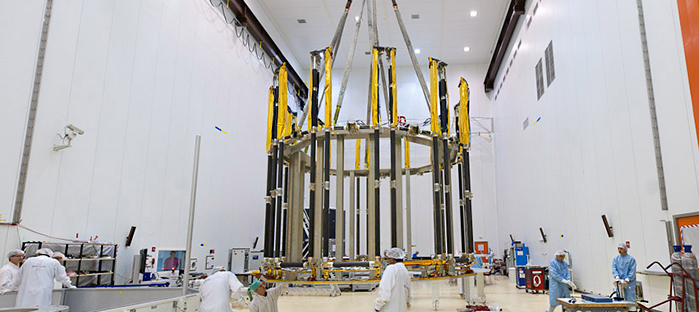

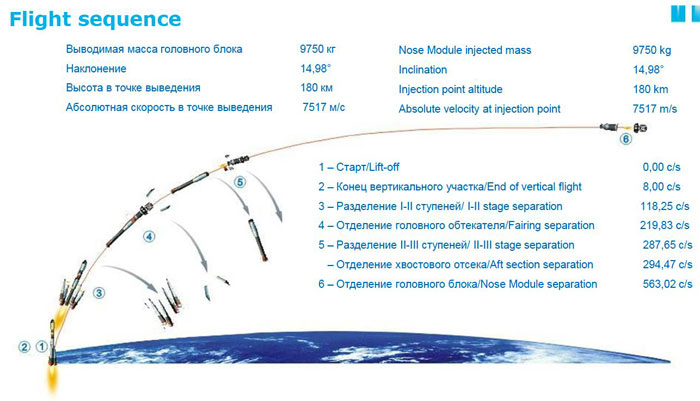
.
Update: 7.10.2013
The Milky Way-mapping Gaia spacecraft receives its sunshield in preparation for Arianespace's next Soyuz launch
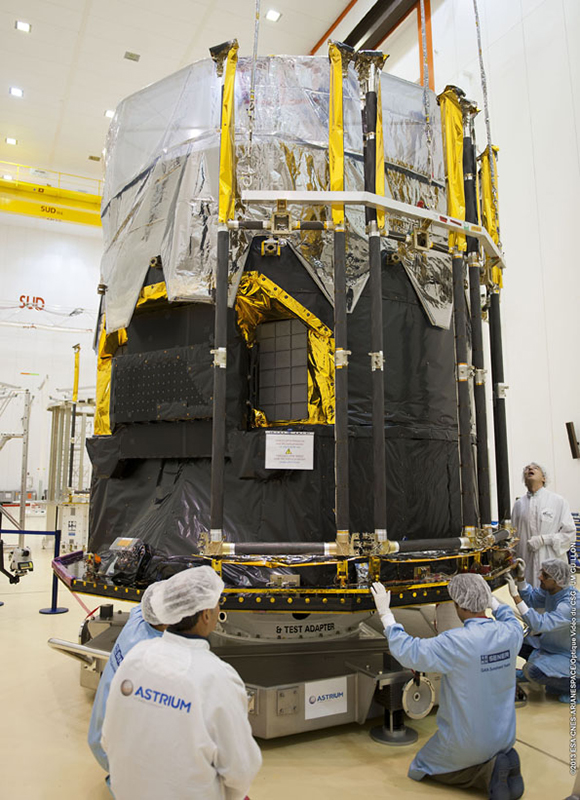
Team members from SENER and Astrium oversee the installation of Gaia’s sunshield framework on the hexagonal/conical-shaped spacecraft at the Spaceport in French Guiana.
.
.
Update: 12.10.2013
Continued sunshield preparations bring Gaia closer to its deep-space Arianespace Soyuz launch
.
Soyuz Flight VS06
Payload preparations for Arianespace’s next Soyuz launch are progressing well at the Spaceport in French Guiana, where the Gaia billion-star surveyor is receiving its sunshield for in-orbit telescope protection as well as power generation.
This sunshield is one of the final elements in completing the European Space Agency’s Gaia, the installation of which has been performed by the assembly, integration and testing team of prime contractor Astrium – with support from Spain’s SENER, which produced the sunshield.
The latest activities involved placement of the inner thermal blankets for Gaia’s multi-layer sunshield insulation, as well as incorporation of solar array panels that will provide energy to power all on-board electronics. Both elements are positioned on the sunshield’s carbon-fiber reinforced composite framework, which also was integrated at the Spaceport.
When the sunshield’s 12 folding frames are opened in orbit after launch by Arianespace’s Soyuz, the fully-insulated sunshield will form a flat disc at the base of Gaia – shading its telescope from the sun and maintaining the spacecraft’s scientific instruments at a constant temperature of approximately -100 degrees Celsius. This will allow Gaia to perform its ambitious mission of making the largest, most precise three-dimensional map of the Milky Way by surveying an unprecedented one percent of its 100 billion stars.
Solar array panels for spacecraft power
The solar array panels fixed to the sunshield will provide approximately 1,850 Watts of electrical power, to be used by Gaia for powering the data processing computers, along with the communications, navigation and thermal control systems.
A massive amount of data will be collected over Gaia’s planned five-year mission, with its full archive to exceed 1 petabyte in size – providing enough information to answer questions related to the origin, structure and evolutionary history of the galaxy.
Gaia will be orbited on Arianespace’s Flight VS06, which is scheduled for liftoff on November 20 from the Spaceport. As indicated by the company’s launcher family numbering designation, this will be the Spaceport’s sixth liftoff with medium-lift vehicle since its introduction at French Guiana in October 2011 by Arianespace.
After being deployed by Soyuz, the 2,030-kg. hexagonal/conical-shaped spacecraft will follow a flight path to an orbit around the Sun at the second Lagrange point (L2) – a distance of 1.5 million kilometers from Earth. This makes Gaia the first deep space payload launched by Arianespace with Soyuz from the Spaceport.
.

The 12 frames of Gaia’s sunshield are hinged on the spacecraft at its base, and they open 90 degrees. When all thermal blankets are integrated on the framework, the sunshield will form a flat disc at the base of the spacecraft, with a diameter of just over 10 meters.
Quelle: arianespace
.
Update: 17.10.2013
.
Gaia “opens up” at the Spaceport in preparation for Arianespace’s next Soyuz launch
Soyuz Flight VS06
.
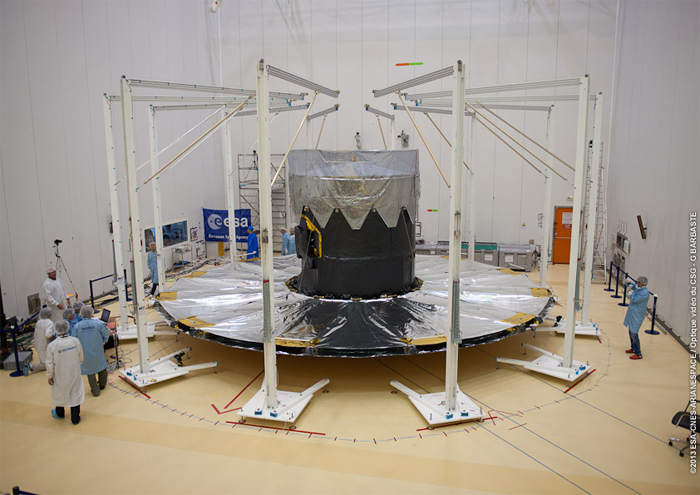
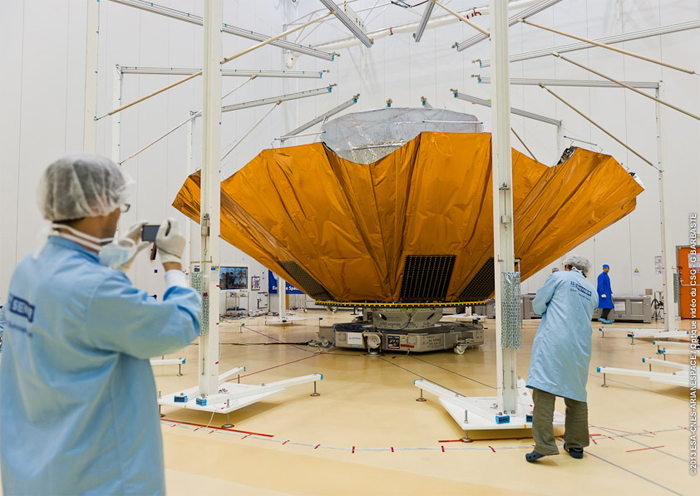

.
Update: 23.10.2013
.
-
Update: 23.30 MESZ
.
.
Update: 29.10.2013
.
Gaia Mission Control Teams absolvieren ein intensives Simulationstraining
.
.
Update: 22.11.2013
.
Arianespace Flight VS06 Soyuz ST-B - Gaia
Launch set for Thursday, December 19, 2013
Evry, November 22, 2013. The checks on the Gaia satellite are proceeding nominally, enabling Arianespace in agreement with ESA to announce the launch date.
Liftoff of the Soyuz ST-B launcher is set for Thursday, December 19, at precisely:
09:12:18 am (UTC)
06:12:18 am (local time in French Guiana)
10:12:18 am (Paris)
04:12:18 am (Washington, D.C.)
12:12:18 pm (Moscow)
.
Quelle: arianespace
.
Update: 27.11.2013
.

.
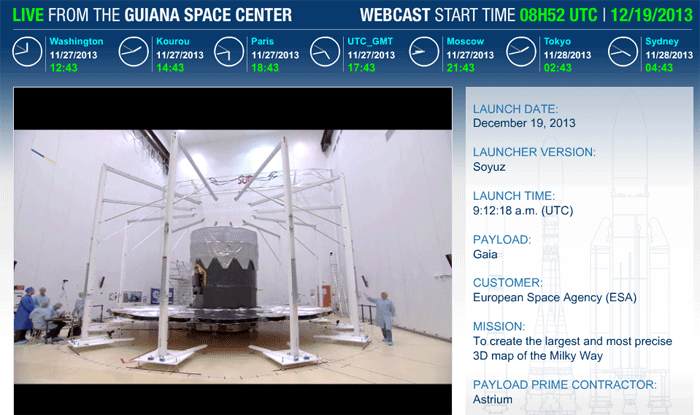
Quelle: arianespace
.
Update: 2.12.2013

.
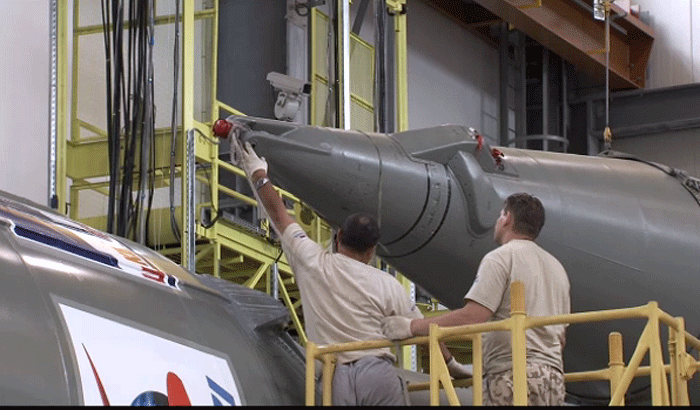
.
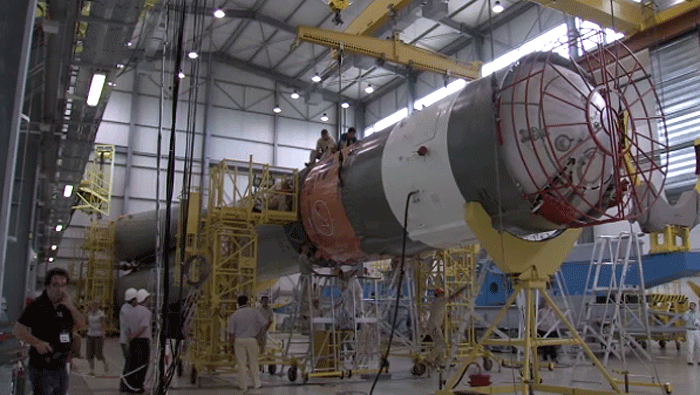
Quelle: ESA
.
Update: 9.12.2013
.
Gaia ready for fuelling
.
Towards the end of November, the first part of the Gaia launch preparation was complete: the satellite was 90% ready, with its tanks pressurised. The second part begins with filling the tanks with the appropriate propellants. This phase is particularly dangerous because the propellants are toxic, and there is also a risk of explosion, so it is carried out in a dedicated building. That’s why Gaia had to move from building S1B in the payload preparation complex (EPCU), where it has been since the start of the campaign, to the S5 building to be fuelled.
.
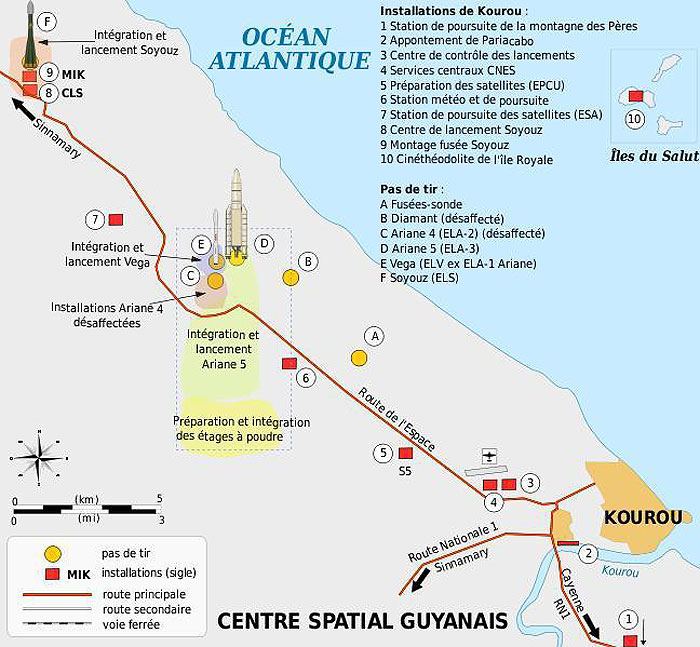
Three months before the start of the launch campaign we had to define the logo to be put on the launcher fairing, to ensure it would be ready for launch. Earlier this year we had already put in place the main characteristics of the Gaia logo: stars, Earth, spacecraft, the Gaia goddess and Gaia name. But one of the main themes we wanted to represent is humankind’s curiosity towards the Universe. Quickly, different options were ready. Christophe, our graphic designer at ESTEC, came up with a very nice representation of the Milky Way. Elizabeth, from Toulouse, suggested that the girl staring at the sky should be trying to reach it. However, the presentation of the girl, the Gaia goddess linking Earth with the sky and stars, was difficult. Several options were proposed but it was difficult to get everyone to agree.
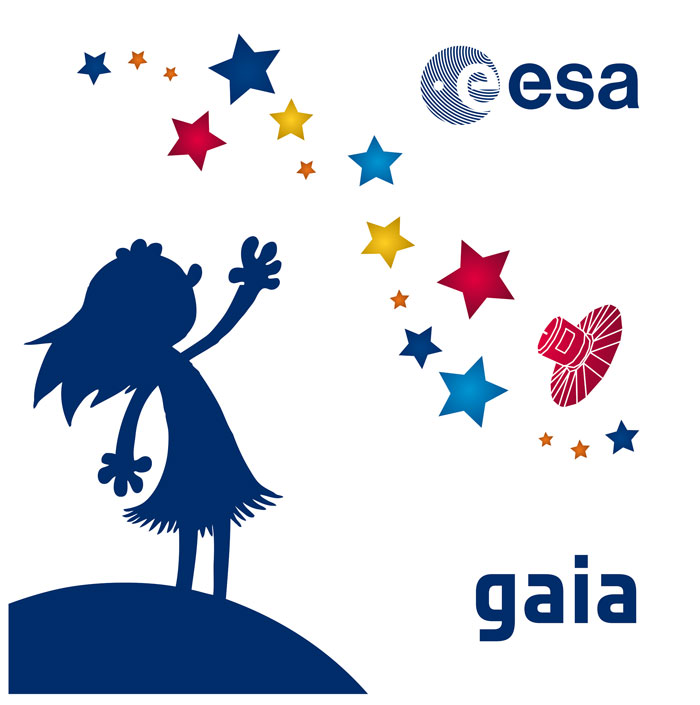
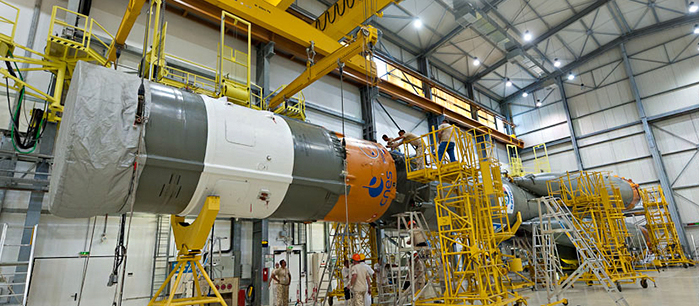
.
Update: 11.12.2013

.
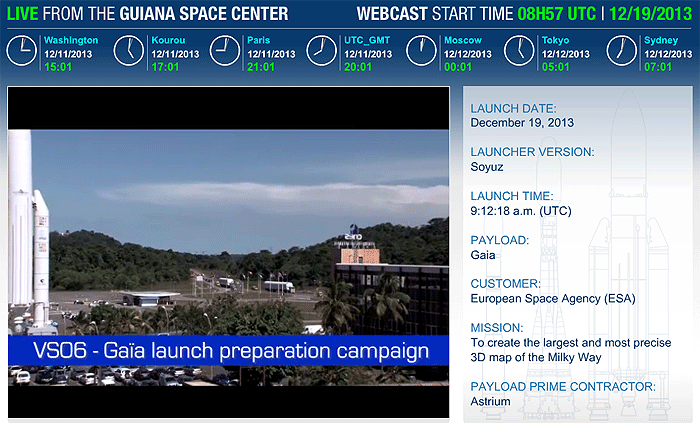
Quelle: arianespace
.
Update: 13.12.2013
.
Gaia is positioned for its star-mapping launch on an Arianespace Soyuz
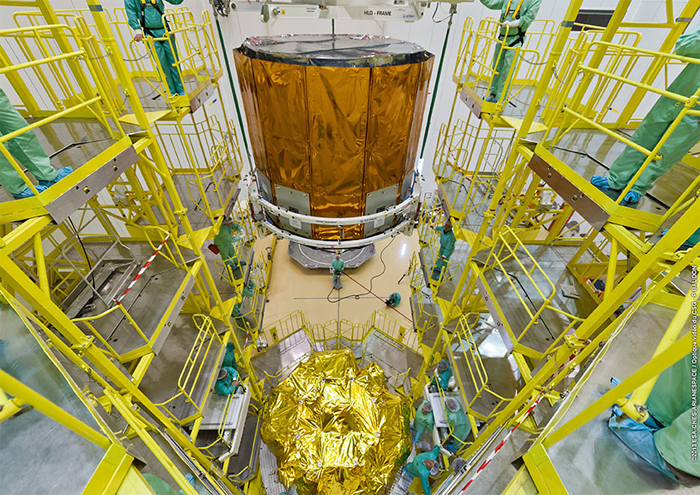

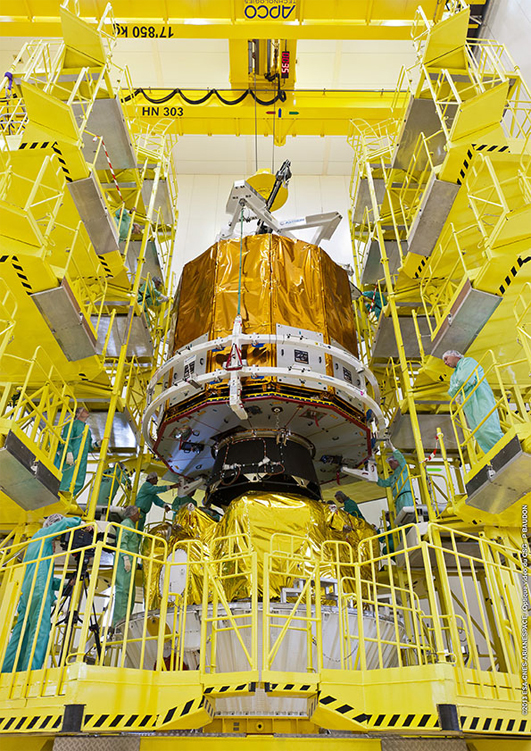
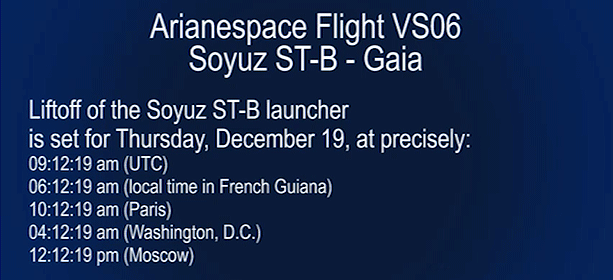
.
Update:
.
GAIA SECURED INSIDE FAIRING
.

.

